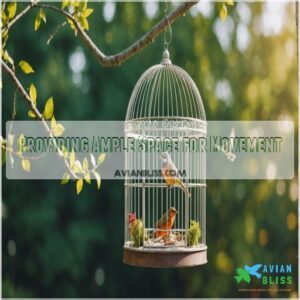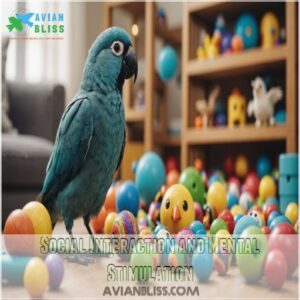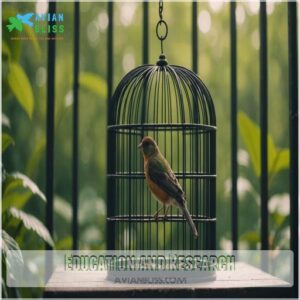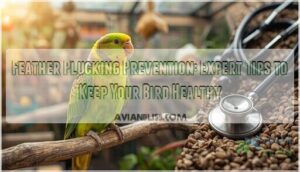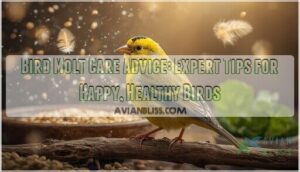This site is supported by our readers. We may earn a commission, at no cost to you, if you purchase through links.
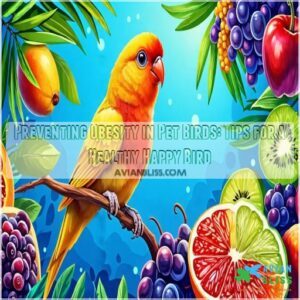
Start by checking out your bird’s cage size; think more aviary, less shoebox.
Encourage flying around the house to burn calories.
When it comes to food, remember the mantra: variety is the spice of avian life, so nix those fatty treats.
Introduce a pellet-based diet gradually to make sure you’re providing a balanced diet.
Toss in some toys to keep your bird mentally fit, and involve them in your daily routine to prevent boredom.
Concerned about missing a step? There’s more to uncover about keeping your feathered friend fit!
Table Of Contents
- Key Takeaways
- Recognizing Obesity in Birds
- Why Birds Become Overweight
- Proper Diet for Birds
- Physical Activity and Exercise
- Proper Feeding Techniques
- Regular Veterinary Care
- Weight Monitoring and Management
- Environmental Considerations
- Social Interaction and Mental Stimulation
- Education and Research
- Frequently Asked Questions (FAQs)
- Why is my pet bird overweight?
- How can I reduce my pet bird’s weight?
- Are companion birds obese?
- How to improve the health of your pet bird?
- How do I make my bird lose weight?
- How can we prevent obesity in pets?
- How do birds minimize weight?
- How can we prevent obesity in chickens?
- How does stress affect bird obesity?
- Are genetic factors significant in bird obesity?
- What role does bird sleep play in obesity?
- Can environmental toxins contribute to bird obesity?
- How do feathers affect weight perception in birds?
- Conclusion
Key Takeaways
- Provide a balanced diet, emphasizing pellets and fresh foods while limiting high-fat seeds and sugary treats. Monitor portion sizes and avoid free-feeding.
- Ensure your bird has ample space to move and fly; a large cage and opportunities for supervised free flight are essential. Use foraging toys to encourage activity.
- Stimulate your bird mentally with a variety of toys, puzzles, and interactive play to prevent boredom and stress-related overeating. Regular interaction is key.
- Schedule regular veterinary check-ups to monitor your bird’s weight, body condition, and overall health. Address any health concerns promptly.
Recognizing Obesity in Birds
Spotting obesity in your feathered friend isn’t always easy, but knowing the signs can make a big difference.
Look for noticeable fat deposits, difficulty flying, and changes in your bird’s posture or breathing; these are all clues that your bird might need a healthier lifestyle.
Visible Signs of Obesity
Spotting bird obesity can be a game of noticing little clues.
Look for fat deposits on your pet bird’s abdomen and sides, or an absent abdominal tuck.
A wider stance while perched might hint at weight woes.
Breathing difficulties and an overgrown beak also signal obesity.
Keeping an eye out for these visible signs aids in timely bird weight loss strategies.
Behavioral Changes
You might notice changes in your bird’s behavior as a sign of obesity.
A lethargic bird, reluctant to play with its toys or exercise, could be experiencing stress signs due to weight gain, similar to issues seen in an overweight cockatiel.
It’s important to encourage foraging behavior and adjust cage design to meet exercise needs, preventing boredom and promoting healthy bird nutrition.
Health Risks
Obesity in birds is no minor issue—think of it as an open invitation to a host of bird health problems.
Extra weight can trigger heart disease, fatty liver disease, and diabetes, just like that.
Arthritic joints and egg binding in birds also join this unwelcome party.
Addressing obesity isn’t just a feather in your cap—it’s a lifesaver for your pet bird.
Why Birds Become Overweight
Birds can gain weight due to overfeeding, lack of exercise, or genetics, with medications sometimes playing a part.
Overeating can be caused by boredom and stress, making captivity a primary factor in pet bird obesity.
Overfeeding and Lack of Exercise
Sometimes, it’s easy to overestimate your bird’s food needs, leading to overfeeding and lack of exercise, which is a common culprit in bird obesity.
If your bird is already showing signs of obesity, consider exploring bird obesity treatment options.
Make sure your feathered friend stays fit by considering:
- Bird food choices: To prevent obesity, it’s crucial to provide a varied diet that meets nutritional needs, such as those found in bird food for picky eaters. Opt for balanced options.
- Exercise routines: Encourage daily physical activity.
- Calorie counting: Monitor treats and rewards to prevent excess calories.
Genetics and Medication
Genetic predisposition can make certain bird species more prone to obesity, a bit like inheriting your aunt’s favorite pie recipe that goes straight to the hips.
Keep an eye out for signs of illness, such as parrot not eating and sleeping, as they can also impact a bird’s weight.
Medications sometimes cause unwanted weight gain, so it’s important to monitor any medication effects.
Regular genetic testing and avian veterinary care can help in managing breed-specific risks, and a well-planned diet consisting of top rated parrot food brands, safeguarding your pet bird’s health.
Boredom and Stress
A bored bird is a stressed bird, and a stressed bird often overeats.
Think of it like this: your feathered friend needs mental stimulation!
Provide plenty of stress-reducing toys, cage enrichment, and boredom-busting activities.
Establish playtime routines and make sure social interaction happens.
A happy, mentally stimulated bird is less likely to overeat, improving their bird mental health and overall well-being.
Remember, a balanced diet and exercise are also essential for a healthy weight.
Proper Diet for Birds
To keep your feathered friend healthy, focus on providing a balanced diet that minimizes high-fat and sugary foods.
Start by monitoring portion sizes and gradually introduce a pellet-based diet for the best nutrition.
Feeding a Balanced Diet
Your bird’s diet can shift from monotonous seeds to vibrant, balanced meals.
Think of it like flipping from black-and-white TV to color.
Here’s how:
- Introduce seed alternatives that offer consistent nutrition.
- Embrace fresh food benefits by mixing fruits and veggies.
- Follow a portion size guide, ensuring you’re serving just the right amount.
These steps promise a healthier and happier feathered friend.
Limiting Fatty and Sugary Foods
A bird’s health thrives when offering a balanced diet that includes a mix of seeds, fruits, and pellets, as recommended by an avian veterinarian. A bird’s health thrives when you steer clear of fatty and sugary foods.
Instead, opt for healthy seed alternatives and sugar-free options.
Use treats as rewards, not staples.
Homemade bird treats can be a fun addition, just avoid processed foods.
This approach to bird nutrition supports obesity prevention, tackling parrot health problems like beak and nail issues.
Monitoring Portion Sizes
While cutting back on fatty and sugary foods, it’s also key to monitor your bird’s portion sizes.
Control seed intake and keep an eye on treat frequency.
Limit food bowl time to prevent grazing, and practice calorie counting for effective bird weight management.
This helps in obesity prevention, ensuring a healthy bird weight and consistent weight monitoring.
Gradually Introducing a Pellet-Based Diet
As you measure those portions with the precision of a chef, think about introducing pellets into your bird’s diet, knowing that pellets should make up 50-70% of a bird’s daily intake for a proper bird nutrition guide.
A dietary shift, skillfully handled, will help reduce those fatty seeds.
Your feathered friend might resist at first, but persevere.
You’ll soon see the benefits: increased activity, better health, and fewer owner concerns about bird wellness and health.
Physical Activity and Exercise
To prevent obesity in your pet bird, make sure they’ve plenty of space to move and opportunities to fly, strengthening their muscles and reducing excess weight.
Enrich their environment with toys and activities that encourage physical and mental engagement, helping to keep them active and healthy.
Providing Ample Space for Movement
A balanced diet‘s only half the battle; think of exercise as the other half.
Proper cage size recommendations are key, with a minimum of 18x18x20 inches for one parakeet as a good starting point, as seen in optimal parakeet cage sizes.
Aim for spaciousness, allowing your feathered friend plenty of room to move around.
Provide varied perching options and climbing toys to encourage activity.
Think of it like a bird gym!
This helps maintain avian health and extends their bird lifespan.
Remember, a happy, active bird is a healthy bird.
Encouraging Flight Opportunities
Think your feathered friend needs more space? Let’s chat about encouraging flight opportunities. This boosts activity and helps prevent obesity. Here’s the game plan:
- Stop wing-clipping: Allow natural flight.
- Create bird-safe rooms: Make sure safe indoor flight is possible.
- Try flight training: Gradual practice builds endurance.
- Set up a bird playground: Encourages regular exercise.
Educating yourself promotes bird wellness.
Offering Toys and Enrichment Activities
Birds need flight, but they also need mental stimulation through toys and enrichment activities.
By providing foraging toys and bird puzzles, you keep them active and engaged.
Interactive games offer great enrichment ideas, preventing boredom and overeating.
A well-stimulated bird can tackle heat stress better, boosting immunity.
Regular veterinary care for birds helps them stay happy and healthy.
Proper Feeding Techniques
Proper feeding techniques are essential to keep your feathered friend at a healthy weight, as they prevent overeating and guarantee balanced nutrition.
Foraging toys, rotating food types, and setting regular mealtimes can help you maintain your bird’s health and happiness.
Using Foraging Toys
Your bird’s environment can spring into life with foraging toys!
By engaging their hungry minds, you foster both mental and physical activity.
Try these:
- Bird-specific toys for safety.
- DIY foraging with hidden treats.
- Toy rotation to maintain interest.
- Enrichment benefits include reducing boredom and stress.
It’s like a puzzle feast for your feathered friend!
Rotating Food Types
Switching up your bird’s meals isn’t just about taste—though it keeps them guessing!
Rotating food types offers various nutritional benefits, essential for balanced health.
By introducing new flavors, you prevent boredom and cater to your bird’s taste preferences, making mealtime enjoyable.
Dietary rotation helps guarantee they receive a wide range of nutrients, supporting a healthy, vibrant life.
Avoiding Free-Feeding
Rotating food types can keep your bird engaged, but avoiding free-feeding is key to portion control.
Imagine yourself in a buffet: endless choices lead to overindulgence.
Instead, opt for:
- Mealtime routines: Offer meals at set times.
- Controlled feeding: Serve specific portions.
- Scheduled meals: Stick to a timetable.
- Feeding schedules: Limit grazing opportunities.
These steps will keep your bird healthy.
Establishing Regular Mealtimes
Several benefits come with establishing consistent mealtime routines for your feathered friend.
A structured food schedule helps prevent overeating, mirroring natural bird feeding habits. This approach offers control and predictability, reducing stress.
By incorporating low-calorie bird food options like low-calorie seeds into your bird’s diet, you can further promote healthy eating habits.
| Time | Meal Type | Notes |
|---|---|---|
| 7:00 AM | Small portion of pellets | Start the day with a healthy base |
| 12:00 PM | Fresh fruits & veggies | Offer variety; remove uneaten portions |
| 5:00 PM | Small amount of seeds | Treat, not a staple |
Regular mealtimes promote a healthier weight, preventing obesity and related health problems.
Regular Veterinary Care
Regular veterinary care is very important to preventing obesity in your pet bird, as routine check-ups help you monitor their weight and body condition effectively.
By addressing any health concerns promptly, you can keep your feathered friend healthy and avoid any weight-related issues that might arise.
Scheduling Routine Check-ups
Securing regular avian vet visits is your bird’s secret weapon against obesity.
These check-ups aren’t just routine—they’re preventative care, aimed at early detection of health issues.
Think of them as a spa day with a side of weight management advice.
Your bird will thank you for the health monitoring and care, keeping them happy and hopping for years to come.
Monitoring Weight and Body Condition
Regular check-ups are golden, but don’t forget about monitoring weight and body condition at home.
Use bird weight charts and note any weight fluctuations.
Here’s how:
- Healthy weight range: Know what’s normal for your bird’s species.
- Visual cues: Look for changes in shape.
- Body condition score: Check with a vet, ensuring a fit feathered friend.
Addressing Any Health Concerns
Spotting any weight changes? It might be time to check in with your avian vet.
A well-balanced diet that excludes high-lactose foods like soft cheese (Understanding Cheese and Birds) is crucial in maintaining a healthy weight for your bird. Routine veterinary visits play an important role in managing bird health issues and ensuring your feathered friend stays on the right track.
Besides, who wouldn’t want their pet to enjoy preventative care and personalized dietary adjustments? Keep those wings healthy and the bird chirpy!
Weight Monitoring and Management
Regularly weighing your bird and recording weight trends is key to preventing obesity and ensuring a healthy lifestyle.
Don’t hesitate to consult an avian veterinarian to determine the ideal weight range for your feathered friend, ensuring you’re on the right track.
Weighing The Bird Regularly
Weighing your bird regularly is like having a friendly chat with a scale to keep tabs on its health.
Use a reliable home scale to guarantee scale accuracy and check with avian vet advice for the ideal weight.
This simple habit helps you monitor your pet’s weight trends, ensuring it stays fit and chirpy, not plump and sedentary.
Recording Weight Trends
Consistent monitoring is key! Use a weight chart or tracking tool to record your bird’s weight weekly. This helps you spot trends early, preventing surprises.
Aim for consistent weigh-ins to track progress toward ideal weight goals.
Remember, veterinarian guidance is invaluable; they can help you set realistic targets and interpret weight changes. Don’t hesitate to ask questions.
Consulting a Veterinarian Regarding Desired Weight Range
With your bird’s weight trends in hand, it’s time to have a chat with your avian veterinarian.
They offer expertise in Avian Weight Management and can counsel on the Ideal Body Condition for your feathered friend.
Establishing Healthy Weight Ranges is a key part of Obesity Prevention Strategies, ensuring your bird thrives and flutters with ease.
Environmental Considerations
Creating the right environment for your pet bird is key to preventing obesity.
You should manage temperature and humidity.
Make certain of adequate lighting.
Maintain a stress-free space to keep your bird healthy and active.
Regulating Temperature and Humidity
Keeping your feathered friend comfy involves knowing their Avian Climate Needs.
Start with these tips:
- Thermometer Placement: Make sure it’s central for accurate readings.
- Temperature Zones: Create varied zones for the bird to choose from.
- Humidity Control Methods: Use a humidifier or mist the air.
- Environmental Thermoregulation: Balance temp and humidity to mimic natural habitats.
Providing Adequate Lighting
Humidity affects your bird’s comfort, much like how lighting impacts their wellbeing.
Providing adequate lighting means thinking about bird-friendly lighting and appropriate lighting cycle management.
Consider lighting color options that cater to avian visual needs.
UV lamp alternatives can help if sunlight isn’t accessible.
Just imagine how these choices will brighten up your bird’s life and mood!
Avoiding Stressful Environments
A stressful environment can lead to overeating in birds.
Think about your bird’s cage placement; strategic placement minimizes noise and maximizes natural light exposure.
Implement noise reduction methods, like using calming music.
Providing healthy bird snacks, such as fresh healthy treats, can also promote overall well-being.
Bird room design matters; create a calm, quiet space.
Consider these factors for a happier, healthier bird.
Remember, a relaxed bird is less likely to overeat.
Social Interaction and Mental Stimulation
To keep your pet bird healthy and prevent obesity, engaging it in social interaction and mental stimulation is essential.
Regular playtime and interaction can help prevent boredom and loneliness, keeping your bird active and mentally sharp.
Offering Mental Stimulation Through Socialization
While engaging your bird, think of socialization as more than just company—it’s about crafting a stimulating environment.
Consider these tips:
- Bird Playdates: Introduce them to new feathered friends.
- Toy Rotation Ideas: Swap out toys regularly to keep things fresh.
- Avian Training Tips: Teach simple tricks to boost your bird’s mental agility.
These activities enhance mental well-being, aiding in obesity prevention.
Encouraging Playtime and Interaction
Imagining your parrot performing tricks like a tiny acrobat isn’t just a fun dream.
It’s possible when you encourage playtime with bird-friendly toy ideas and environmental enrichment activities.
Create a bird agility course right in your living room, mixing in sensory stimulation methods and tricks and training exercises.
These interactions bolster health, preventing those pesky extra pounds from piling on.
Avoiding Loneliness
Your bird craves companionship and mental stimulation to avoid loneliness.
Consider these tips:
- Bird Socialization: Introduce other birds for company.
- Cage Setup: Arrange the cage with engaging toys.
- Environmental Enrichment: Rotate activities to maintain interest.
- Interactive Play: Spend time bonding through play and conversation.
Create an environment rich in interaction and joy.
Education and Research
To effectively prevent obesity in your pet bird, it’s important to stay informed about avian nutrition and health.
Enhance your knowledge by participating in avian research studies and attending educational events and seminars that focus on bird care.
Staying Informed About Bird Nutrition and Health
A well-rounded approach to bird care includes staying updated on nutrition. Understanding your bird’s needs is key to preventing obesity.
Here’s a helpful guide:
| Topic | Resource Type | Reliability |
|---|---|---|
| Bird Nutrient Deficiency | Avian veterinary journals | High |
| Bird Food Safety | Reputable pet food brands | Medium |
| Breeding Bird Health | University research | High |
| Pet Bird Psychology | Bird behavior books | Medium |
Regularly review this information; it’s important for your feathered friend’s health. Consult an avian vet for personalized advice.
Participating in Avian Research Studies
Understanding the importance of a stable environment, as it can contribute to preventing seizures in pet birds, especially those prone to environmental stressors, is crucial. Jump into avian research studies to deepen your understanding of bird health.
You’ll find roles like:
- Avian Study Participation: Engage directly in studies.
- Bird Nutrition Trials: Help test new diets.
- Research Volunteer Roles: Assist with experiments.
- Study Design Feedback: Share insights on study approaches.
It’s a fun way to learn while contributing to science and avian well-being.
Attending Educational Events and Seminars
Participating in avian research studies offers rich experiences.
Attending Avian Health Workshops and Bird Behavior Conferences opens up a whole new world for ongoing education.
You’ll meet experts and enthusiasts alike, swapping stories and tips over coffee, and discussing various topics like how long bird eggs hatch.
Pet Bird Nutrition Seminars and Veterinary Care Forums offer practical insights too.
These gatherings promise not just learning, but a sense of belonging in a feathered community.
Frequently Asked Questions (FAQs)
Why is my pet bird overweight?
Overfeeding, lack of exercise, genetics, and certain medications can all contribute to your bird’s weight gain.
A vet visit can help determine the exact cause and create a personalized weight-loss plan.
How can I reduce my pet bird’s weight?
Is your feathered friend a little too fluffy?
Start by consulting an avian vet.
Reduce high-fat seeds and increase exercise.
Encourage foraging with toys, and gradually introduce a balanced diet of pellets, fruits, and veggies.
Are companion birds obese?
Companion birds can become obese due to factors like overfeeding, lack of exercise, and genetics.
You can prevent obesity by managing their diet, providing exercise opportunities, and ensuring mental stimulation through toys and foraging activities.
How to improve the health of your pet bird?
Did you know birds expend 20 times more energy flying?
Keep your bird lively with a balanced diet, ample exercise, and mental stimulation.
Consult an avian vet for diet tips, and regularly monitor weight for best results.
How do I make my bird lose weight?
To help your bird lose weight, consult an avian vet.
To start making changes, adjust its diet to include more pellets and fresh foods.
Increase exercise through flight opportunities and foraging activities.
Keep it active and engaged daily.
How can we prevent obesity in pets?
Isn’t it curious how pets mirror our waistlines?
Keep them trim by balancing meals, limiting treats, and encouraging exercise through play.
Just like us, they need fun and boundaries to stay in shape and healthy.
How do birds minimize weight?
Birds minimize weight naturally through flight, which burns significant calories.
Free-flying time and foraging toys provide exercise in captivity.
A balanced diet, low in high-fat seeds, helps maintain a healthy weight, too.
How can we prevent obesity in chickens?
Remember that plump hen you saw? She’s a cautionary tale!
Control portions, offer a balanced diet of pellets, veggies, and limited treats.
Encourage activity; a larger coop helps.
Regular weigh-ins are key.
How does stress affect bird obesity?
Stress in birds can lead to obesity by causing overeating as a coping mechanism.
When birds feel anxious or bored, they may consume more food than needed, leading to weight gain, much like humans stress-eat snacks.
Are genetic factors significant in bird obesity?
Just like a puzzle, genetic factors can play a significant role in bird obesity.
Certain species might be predisposed to weight gain.
While genes aren’t the sole culprit, they add complexity to managing a bird’s weight.
What role does bird sleep play in obesity?
Birds need plenty of sleep, as poor sleep can lead to stress and disrupted eating patterns, potentially contributing to obesity.
Make sure your bird gets 10-12 hours of uninterrupted rest in a quiet, dark environment daily.
Can environmental toxins contribute to bird obesity?
Environmental toxins can affect bird metabolism, potentially contributing to obesity.
Chemicals from polluted air or contaminated food might alter hormone levels, affecting appetite and weight.
Keeping the environment clean helps control these risks, supporting your bird’s health.
How do feathers affect weight perception in birds?
Feathers, like a fluffy coat, can disguise a bird’s true size, making them appear plumper than they are.
This effect can hinder your ability to accurately assess their weight.
This can potentially mask issues like obesity or weight loss.
Conclusion
Balancing your bird’s well-being isn’t just about avoiding fatty seeds; it’s a dance between nutrition and activity.
Remember, preventing obesity in pet birds is essential for their health.
By offering a varied diet, encouraging movement, and providing mental stimulation, you’re setting the stage for a joyful, active life.
Don’t forget the vet visits to track weight.
With mindful care, your feathered friend will stay in top shape, fluttering happily alongside you.




